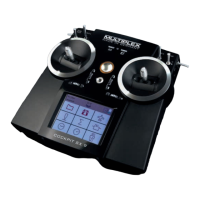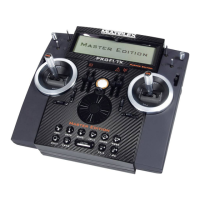ROYAL SX
32
12. Setting up a fixed-wing model
We recommend that you first read Chapter 11, which
describes the operating philosophy of the ROYAL SX,
before you set up a new model in a memory. This
should ensure that you have at least a basic under-
standing of the system, and will be able to carry out
the following steps more easily.
12.1. The method in principle
In this example we will set up a model memory for a
glider with a four-flap wing.
The following steps have to be carried out to ensure
that the model’s basic functions work as expected:
a. Set up new model memory 12.2.
b. Prepare transmitter controls and switches 12.3.
c. Prepare servos 12.4.
d. Activate and check mixed functions 12.5.
Example: ailerons raised as landing aid.
After these four steps you will be able to control the
model’s basic functions, i.e. aileron, elevator, rudder
and throttle. Butterfly (Crow) is activated as landing
aid.
At this point you can expand and refine the set-up:
e. Activate Combi-Switch 12.11.2.
f. Set up aileron differential 12.6.
g. Elevator trim mixers 12.7.
spoiler / throttle to elevator mixers
h. Activate the inboard wing flaps 12.8.
i. V-tail model 12.9.
j. Working with flight phases 12.10.
Assign switch
Unlock / lock / name phases
Set transition times
Adjust values
k. Further options that can be added 12.11.
Dual-Rate (D/R), Expo,
Combi-Switch, Motor run timer.
12.2. Setting up the new model in the
transmitter
12.2.1. Menu I, call up New model
a. Open the main menu Memory:
Press button I.
b. Open the menu New model:
Turn the 3-D digi-adjuster to the right as far as New
model, and open the menu
(press 3-D digi-adjuster):
¦New model
¨Exit
Memory nr. 3
Template 4 FLAPS
Servo conf. MPX-UNI
Mode 4: è é
Assignment GLIDER
OK
Note:
The new model is not stored in the memory until you
confirm the selected settings with OK ( 12.2.7.).
12.2.2. Which model memory will be used?
New models are automatically stored in the first va-
cant memory; the memory number appears in the
menu. Since you have no influence over the memory
number, this line in the menu is skipped.
If all model memories are in use, the screen displays:
Memory nr. -1
If you nevertheless attempt to set up the new model,
the following on-screen warning appears:
No memory free
Press ENTER
12.2.3. Selecting the Template
Note:
The templates ( 11.5.) make it much quicker and
easier to create new models, as they already contain
the essential assignments and settings. You can
check which template was used to create a particular
model by accessing the menu ¦Memory, Properties.
Turn the 3-D digi-adjuster to the right until the select
bar stands in the Template line, then press the 3-D
digi-adjuster.
Now you can select the template 4 FLAPS from the
eight available templates, using the 3-D digi-adjuster:
¦New model
¨Exit
Memory nr. 3
Template 4 FLAPS
Servo conf. MPX-UNI
Mode 4: è é
Assignment GLIDER
OK
Press the 3-D adjuster once more to confirm your
choice.
12.2.4. Selecting the servo configuration (servo
conf.)
Note:
The servo configuration ( 11.6.) defines the order in
which the servos have to be connected to the receiver
in the model. The selected configuration is only a
suggestion, and can be changed subsequently in any
way you wish if the servos are connected to different
receiver outputs ( Menu: K, Assignment).
Rotate the 3-D digi-adjuster to the right until the select
bar is at the Servo conf. line, then press the 3-D
digi-adjuster.
12.2.2.
12.2.3.
12.2.4.
12.2.5.
12.2.6.
12.2.7.

